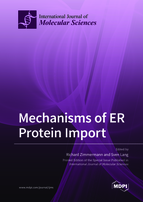Mechanisms of ER Protein Import
A special issue of International Journal of Molecular Sciences (ISSN 1422-0067). This special issue belongs to the section "Biochemistry".
Deadline for manuscript submissions: closed (30 June 2021) | Viewed by 53869
Special Issue Editors
Interests: human endoplasmic reticulum; protein import into the ER; calcium leakage from the ER; ATP/ADP exchange; molecular chaperones of the ER; Sec61 channel gating; Sec61-channelopathies; chaperonopathies
Interests: ATP transport; calcium homeostasis; calcium leakage; endoplasmic reticulum; membrane proteins; protein-protein interactions; protein targeting; protein transport; Sec61-channelopathies; Sec61 complex
Special Issue Information
Dear Colleagues,
Protein import into the endoplasmic reticulum (ER) is the first step in the biogenesis of approximately 10,000 different soluble and membrane proteins of mammalian cells, which amounts to about 30% of the proteome. All these proteins fulfill their functions either in the membrane or lumen of the ER itself, in one of the organelles of the pathways for endo- and exocytosis, or at the cell surface as plasma membrane or secreted proteins. ER protein import involves two stages—ER targeting, which guarantees membrane specificity, and the insertion of nascent membrane proteins into or translocation of soluble precursor polypeptides across the ER membrane. Typically, both processes depend on amino-terminal signal peptides or transmembrane helices. However, the targeting reaction may also involve the ER targeting of specific mRNAs. In addition, both processes may occur co- or post-translationally and are facilitated by various sophisticated machineries, which reside in the cytosol and the ER membrane, respectively. Except for resident ER proteins, proteins are delivered to their functional locations by vesicular transport. In this Special Issue, international experts in this area of cell biology report on their structural and mechanistic insights into various aspects of targeting, insertion, and translocation machineries, such as the signal recognition particle (SRP), its corresponding receptor, and the Sec61 complex. Furthermore, small-molecule inhibitors and toxins that interfere with ER protein import will be discussed in detail. With the last topic, this Special Issue provides a timely glimpse of how scientific analyses of ER protein import can contribute to the development of future therapeutic strategies against viruses, including SARS-CoV-2.
Prof. Dr. Richard Zimmermann
Dr. Sven Lang
Guest Editors
Manuscript Submission Information
Manuscripts should be submitted online at www.mdpi.com by registering and logging in to this website. Once you are registered, click here to go to the submission form. Manuscripts can be submitted until the deadline. All submissions that pass pre-check are peer-reviewed. Accepted papers will be published continuously in the journal (as soon as accepted) and will be listed together on the special issue website. Research articles, review articles as well as short communications are invited. For planned papers, a title and short abstract (about 100 words) can be sent to the Editorial Office for announcement on this website.
Submitted manuscripts should not have been published previously, nor be under consideration for publication elsewhere (except conference proceedings papers). All manuscripts are thoroughly refereed through a single-blind peer-review process. A guide for authors and other relevant information for submission of manuscripts is available on the Instructions for Authors page. International Journal of Molecular Sciences is an international peer-reviewed open access semimonthly journal published by MDPI.
Please visit the Instructions for Authors page before submitting a manuscript. There is an Article Processing Charge (APC) for publication in this open access journal. For details about the APC please see here. Submitted papers should be well formatted and use good English. Authors may use MDPI's English editing service prior to publication or during author revisions.
Keywords
- Protein targeting to the ER
- Insertion of proteins into the ER membrane
- Translocation of proteins into the ER
- Signal peptides
- Transmembrane helices
- Intrinsically disordered domains
- ER-SURF
- SRP/SR
- GET
- SND
- NAC
- Sec61 complex
- Sec61 translocon
- EMC
- PEX3
- TRAP complex
- Oligosaccharyltransferase
- Signal peptidase
- Sec61 channel inhibitors







